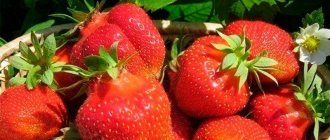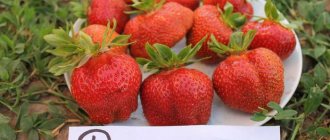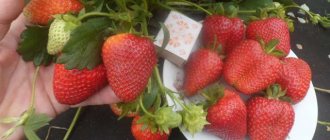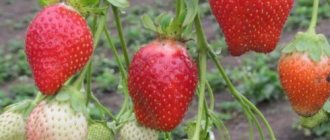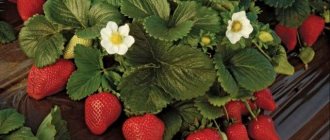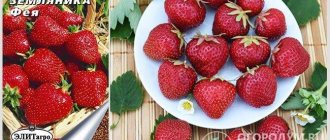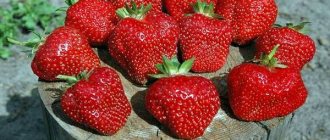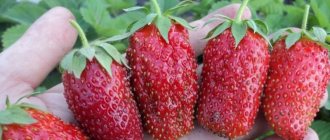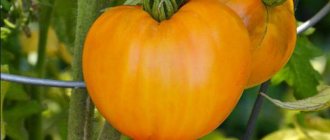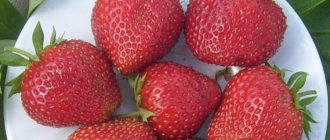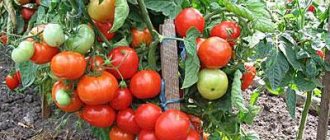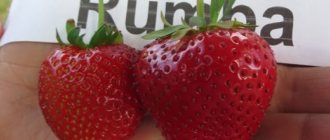Many experienced gardeners prefer to plant time-tested domestic varieties on their plots. There are a lot of new products, you can’t keep track of them all, and the foreign assortment is not always suitable for the climatic conditions of Russia. Strawberry Fairy is precisely one of the stable “oldies”, for the care of which you do not need to study detailed instructions. The variety takes root well and produces a good harvest in almost any region of our country. Fairy can be used for both private and industrial cultivation.
Description of the variety
Strawberry Fairy was bred in 1970 by Kuibyshev breeders. After 18 years, this wonderful berry was included in the state register of breeding achievements, but in Russia it appeared even earlier; word of mouth quickly spread information about the merits of the variety throughout the Union. The originators recommended Fairy for cultivation in the Volga-Vyatka, East Siberian, and West Siberian regions, but the variety has successfully established itself in the south and in the Moscow region.
Bushes
Fairy bushes are of medium height, slightly spreading, erect. The variety produces a moderate amount of whiskers; there are enough of them for breeding, but the removal work cannot be called burdensome. The flower stalks are powerful, growing at the level of the leaves or slightly below. Numerous flowers are white, bisexual. The variety does not need additional pollinating neighbors.
Berries
The bright red fruits of the first wave of the harvest weigh 35-40 g. They often have a non-standard, comb-like shape. The following berries are beautiful, round or truncated-wide-conical, without a neck. But “beauty requires sacrifice.” These fruits lose weight up to 50%.
The flesh is red, dense, not crunchy, juicy. The taste is traditional, pleasant sweet and sour with a distinct strawberry aroma. Tasters rated the strawberries only 4.0-4.3 points out of 5. Apparently, due to the presence of sourness. Fairy has a high content of vitamin C in fruits - 55 mg%.
Fairy berries behave well during heat treatment and do not become overcooked. Housewives love to make whole fruit jam from it.
Productivity
The Fairy variety is a medium-ripening garden strawberry. It begins to bloom in mid-May, the harvest is harvested in the second decade of June. Each plant can produce up to 50 berries. The collection is carried out in 5-6 waves. Despite the very small last fruits, the yield is about 0.5 kg. from the bush. If you take good care of your strawberry bed, you can get better results.
Fairy variety strawberries
The first fruits in the cluster are large, spectacular - they fill up to 25 - 40 g; The average weight for the season is 10 – 15g. The inflorescences are branched, with numerous ovaries, which ripen gradually (5 - 6 collections are required). On one bush, up to 50 fruits are formed with a total weight of 600 - 1500 g. The yield of Fairy strawberries is determined in the range of 11 - 19 kg per 10 sq. m.
The berries have the shape of a ball or a truncated cone; the largest ones are comb-shaped. No cervix is observed. The color of the skin is deep red, the flesh is scarlet-red. The consistency is delicate, the surface is soft. The taste of the berries is high, but the transportability is average. The pulp is sweet and sour, juicy, fragrant.
a brief description of
Fairy strawberries have been considered one of the best berry crops for growing in the garden for several decades.
Advantages of the variety
- stable good harvest in any weather;
- very high frost resistance;
- survival rate of young seedlings up to 90%;
- does not respond to large temperature changes;
- there is an opportunity to significantly increase productivity with intensive agricultural technology;
- large berries of the first wave;
- high immunity to diseases and resistance to pests;
- harmonious taste;
- It doesn’t produce a lot of whiskers, so the variety is not susceptible to rapid thickening of beds;
- the berries do not become soggy from heat treatment;
- drought resistance, which allows the bushes to survive the summer without rain.
Disadvantages of the variety
The variety also has disadvantages, but they are incomparably fewer than the advantages:
- the last fruits are small;
- if there is excessive moisture, the berries may suffer from gray rot;
- cannot be stored for long periods of time;
- Fairy strawberries are also not suitable for long-distance transportation.
Main characteristics
Let's start with the main characteristics of the variety declared by the originator:
| Parameter | Characteristic |
| Culture | Strawberry (Fragaria L.) |
| Ripening time | Average |
| Fruiting | One-time (non-repairable), stretched (5-6 charges) |
| Photoperiodic type | Short daylight hours |
| Productivity | High: 105-189 c/ha; more than 500 g per bush (up to 1.5 kg with intensive agricultural technology) |
| Mass of berries | First - up to 35-40 g, main collection - 10-15 g |
| Fruit shape | Round or truncated-conical, without neck |
| Berry color | Dark red with a glossy sheen |
| Pulp | Red, juicy, dense |
| Tasting assessment | 4.0-4.3 points (out of 5) |
| Purpose | Universal |
| Flowers | Large, white, bisexual, untwisted |
| Educational ability | Medium (pale red mustache) |
| Sustainability | High winter hardiness and average drought resistance. Slightly affected by diseases and pests |
| Productive life cycle | Volga-Vyatka, West Siberian, East Siberian |
| Year of inclusion in the Federal State Budgetary Institution "State Varietation Commission" | 1988 |
| Originator | State Budgetary Institution of the Samara Region Research Institute of Horticulture and Medicinal Plants “Zhiguli Gardens” (Samara) |
Landing
When planting is done in spring or autumn, the harvest can only be expected after a year. For this reason, gardeners try to plant strawberries in the summer, around the end of July and beginning of August. Before winter, the bushes will have time to take root, grow stronger and form flower buds.
The fairy will grow on any soil and in the shade, but will feel more comfortable on sunny areas, on fertile soil. Fairy strawberries do not like high humidity. When constructing a bed, you need to provide high-quality drainage or arrange high beds.
The area is cleared of weeds in advance, dug up and fertilized (200 g of ash and a bucket of manure per 1 m2). You can apply complex mineral fertilizers. For example, AVA is a long-acting drug that will last for three years.
Planting scheme for the tape method:
- 25 cm between bushes;
- 40 cm between rows;
- row arrangement from north to south.
When planting, you must ensure that the root collar is not deepened. Water the bush and sprinkle straw or sawdust around it to retain moisture.
Growing and care
Fairy strawberries are very attractive for growing due to their unpretentiousness. If the minimum requirements are met, you can enjoy a rich harvest.
Watering
In order not to provoke fruit rot, watering Fairy strawberries should be moderate. Prolonged stagnation of moisture should not be allowed. Drip irrigation is preferred. To prevent the fruit from coming into contact with the ground, you can use black non-woven material.
Loosening, weed control
Like any other crop, Fairy cannot stand the proximity of weeds, which draw nutrients onto themselves, become a breeding ground for diseases, and make ventilation difficult.
Weeds must be combated throughout the season, and do not forget to loosen the beds. To help the modern gardener, agrofibre, which will free you from this tedious task
Removing a mustache
To get good productivity from the Fairy, you need to periodically trim off the excess mustache. Thickening of the beds leads to a decrease in yield and a decrease in the size of the berries.
Top dressing
Regular fertilizing helps increase productivity and resistance to disease. In relation to Fairies, the following scheme gives good results:
- In early spring, plants are fertilized with urea or another fertilizer with a high nitrogen content, which stimulates the active growth of green mass. You can use an infusion of mullein (1:10) or bird droppings (1:20);
- Strawberries will need potassium as soon as buds begin to appear. The soil is treated with ash, sprinkling it between the beds, or diluting it in water;
- in August it is necessary to fertilize the soil with nitroammophos. 1 tablespoon of fertilizer is dissolved in a bucket of water. The resulting solution is poured over the strawberries.
Herbal infusions, which are used several times a season, also do not hurt. Especially in spring and the first half of summer.
Pest and disease control
Strawberry Fairy has an advantage over many modern varieties, as it is resistant to many fungal diseases. However, there are no completely invulnerable plants, so preventive measures will not hurt. If there has been an outbreak of fungal diseases on the site, in early spring the bushes are sprayed with 1% Bordeaux mixture. For the prevention of diseases, you can also use the biological product phytosporin, and in the fight against pests phytoverm.
Preparing for winter
Experience shows that Fairy strawberries do not need shelter even in the northern regions. Therefore, the variety is readily grown by gardeners in Siberia.
The foliage should not be mowed before wintering. But it is better to replace the mulch used during the season with new one to avoid the development of diseases and the proliferation of pests
Strawberry “Fairy”: variety description, photos and reviews
Do you know that:
One of the most convenient methods for preparing a harvest of vegetables, fruits and berries is freezing. Some believe that freezing causes the nutritional and health benefits of plant foods to be lost. As a result of the research, scientists have found that there is practically no decrease in nutritional value when frozen.
Humus is rotted manure or bird droppings. It is prepared like this: the manure is piled up in a heap or pile, layered with sawdust, peat and garden soil. The pile is covered with film to stabilize temperature and humidity (this is necessary to increase the activity of microorganisms). The fertilizer “ripens” within 2-5 years, depending on external conditions and the composition of the feedstock. The output is a loose, homogeneous mass with a pleasant smell of fresh earth.
From varietal tomatoes you can get “your own” seeds for sowing next year (if you really like the variety). But it is useless to do this with hybrids: you will get seeds, but they will carry the hereditary material not of the plant from which they were taken, but of its numerous “ancestors”.
Both humus and compost are rightfully the basis of organic farming. Their presence in the soil significantly increases the yield and improves the taste of vegetables and fruits. They are very similar in properties and appearance, but they should not be confused. Humus is rotted manure or bird droppings. Compost is rotted organic remains of various origins (spoiled food from the kitchen, tops, weeds, thin twigs). Humus is considered a higher quality fertilizer; compost is more accessible.
A new product from American developers is the Tertill robot, which weeds weeds in the garden. The device was invented under the leadership of John Downes (creator of the robot vacuum cleaner) and works autonomously in all weather conditions, moving over uneven surfaces on wheels. At the same time, it cuts off all plants below 3 cm with the built-in trimmer.
Natural toxins are found in many plants; Those grown in gardens and vegetable gardens are no exception. Thus, the seeds of apples, apricots, and peaches contain hydrocyanic acid, and the tops and peels of unripe nightshades (potatoes, eggplants, tomatoes) contain solanine. But do not be afraid: their number is too small.
Convenient Android applications have been developed to help gardeners and gardeners. First of all, these are sowing (lunar, flower, etc.) calendars, thematic magazines, and collections of useful tips. With their help, you can choose a day favorable for planting each type of plant, determine the timing of their ripening and harvest on time.
In Australia, scientists have begun experiments in cloning several varieties of grapes grown in cold regions. Climate warming, which is predicted for the next 50 years, will lead to their disappearance. Australian varieties have excellent characteristics for winemaking and are not susceptible to diseases common in Europe and America.
“Frost-resistant” varieties of garden strawberries (more often simply “strawberries”) need shelter just as much as ordinary varieties (especially in those regions where there are snowless winters or frosts alternating with thaws). All strawberries have superficial roots. This means that without shelter they freeze to death. Sellers’ assurances that strawberries are “frost-resistant,” “winter-hardy,” “tolerates frosts down to −35 ℃,” etc. are deception. Gardeners must remember that no one has yet managed to change the root system of strawberries.
Reproduction
Plantings are renewed every 3 years. Strawberry Fairy reproduces by mustache and division of the bush.
To obtain full-fledged seedlings, flower stalks are cut off on plants intended for propagation. For rooting, place plastic containers under the sockets. Such seedlings tolerate transplantation better.
Experienced gardeners immediately plant the Fairy in rows with a distance of 60 cm. Later, whiskers are directed into the aisles. After they are rooted, the old mother bushes are pruned and dug up. The renewed bed is ready for fruiting next year.
The bush is divided in spring or autumn. One plant can be divided into 2-4 parts. Each should have at least 2 leaves and branched roots. Propagation by seeds is not recommended. The process is labor-intensive and seed germination is low.
Reviews
I have 2 varieties of strawberries growing on my plot – Fairy and Vityaz. A small plot is enough to eat fresh berries and make jam. One year I also tried to plant remontant strawberries. I didn't like the experience. The berries are hard, there is no aroma at all, and in the fall there is an abundance of apples, plums, somehow you don’t want strawberries. I associate strawberries with the beginning of summer, and my varieties allow you to enjoy the berries already in June.
For several years I could not achieve normal results from “Fairy”. The bushes did not grow, the yield was very low. Somehow it coincided that I bought a pH meter for the greenhouse and at the same time checked the acidity in the entire area. In many places, apparently due to mineral fertilizers, the soil was acidified. I chose one of the plots, covered it generously with dolomite flour, dug it up, and the next season planted fresh “Fairy” mustaches. It's a completely different matter. At least I saw the berries, the harvests were not huge, but I really liked the taste of this variety - not cloying, with sourness, this is exactly the kind of berry I love.
Strawberry Fairy is undemanding in care and produces stable productivity. Over the years, it has established itself as a variety with high adaptation capabilities to unfavorable climatic conditions. Suitable not only for personal gardens, but also for commercial plantings, including in risky farming areas.
Features of fruiting and consumer qualities of berries
The variety has an average and long ripening period: flowering begins in mid-May, and the berries ripen from the second decade of June (almost simultaneously with the Festivalnaya strawberries). Plants form a large number of peduncles (10-15 pieces), located at or below the leaves. The inflorescences are semi-spreading, multi-flowered, which ensures the setting and filling of more than 50 berries on the bush. They are collected 5-6 times. The first fruits are the largest (up to 35-40 g), often have a non-standard (comb-like, ribbed) shape. Subsequent berries are truncated-wide-conical or round, without a neck, weighing on average 10-15 g.
The pulp is red, juicy, dense with a pleasant sweet and sour taste and aroma. Tasting scores of fresh fruits are 4.0-4.3 points (out of 5), sugar-acid coefficient 5.6-6.2. The culinary purpose is universal. Berries contain:
The variety has great productivity potential. According to the results of the tests, the average yield was 105 c/ha, and the maximum – 189 c/ha.
The downside of “Fairies” is considered to be the low transportability of the fruit.
